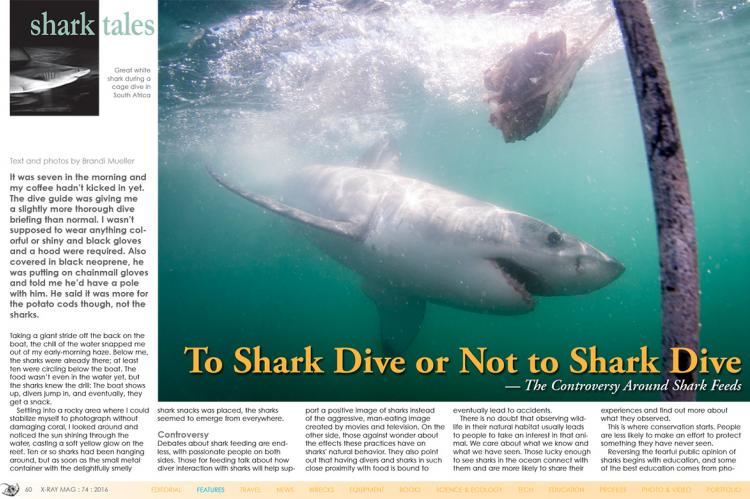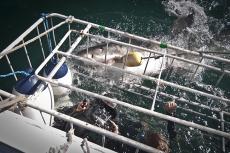To Shark Dive or Not to Shark Dive
It was seven in the morning and my coffee hadn’t kicked in yet. The dive guide was giving me a slightly more thorough dive briefing than normal. I wasn’t supposed to wear anything colorful or shiny, and black gloves and a hood were required. Also covered in black neoprene, he was putting on chainmail gloves and told me he’d have a pole with him. He said it was more for the potato cods though, not the sharks.
Tags & Taxonomy
Taking a giant stride off the back on the boat, the chill of the water snapped me out of my early-morning haze. Below me, the sharks were already there; at least ten were circling below the boat. The food wasn’t even in the water yet, but the sharks knew the drill: The boat shows up, divers jump in, and eventually, they get a snack.
Settling into a rocky area where I could stabilize myself to photograph without damaging coral, I looked around and noticed the sun shining through the water, casting a soft yellow glow on the reef. Ten or so sharks had been hanging around, but as soon as the small metal container with the delightfully smelly shark snacks was in place, the sharks seemed to emerge from everywhere.
Controversy
Debates about shark feeding are endless, with passionate people on both sides. Those for feeding talk about how diver interaction with sharks will help support a positive image of sharks instead of the aggressive, man-eating image created by movies and television. On the other side, those against wonder about the effects these practices have on sharks' natural behavior. They also point out that having divers and sharks in such close proximity with food is bound to eventually lead to accidents.
There is no doubt that observing wildlife in their natural habitat usually leads to people to take an interest in that animal. We care about what we know and what we have seen. Those lucky enough to see sharks in the ocean connect with them and are more likely to share their experiences and find out more about what they observed.
This is where conservation starts. People are less likely to make an effort to protect something they have never seen.
Reversing the fearful public opinion of sharks begins with education, and some of the best education comes from photographs and real-life stories of experiences with sharks. When a group of divers see sharks in the ocean, they will go back home with their photos and videos (and all their limbs) and tell their friends and family that the sharks did not even notice they were there; the sharks were only after the shark food. This information then spreads to others, by those people relaying stories to more people about sharks not being deadly human predators.
Some argue that the stories brought back are still full of fear and negative images of sharks. When a bait bucket is opened, there is nothing sweet or cute about the way the sharks go after the food, nor will photos of tiger and great white sharks ever be depicted as “friendly” or “lovable.”
Not to mention, friends love a good thrill story about how you weren't devoured by 50 sharks in a feeding frenzy: “We dove with tiger sharks and lived to tell the tale”—these stories are still laced with fear and elude to survival of a scary event, when in reality, it wasn't scary at all.
We hope that our photos of these apex predators will help show other people that sharks are not predators of humans—but they don’t often do that. So are we really changing perspectives?
Shark conservation is good business. Shark feeds (and scuba diving) promote tourism and, in many areas, they create an important source of income for poor countries. Research has been done showing that a shark is worth far more in the ocean alive than it is being served up in shark fin soup. But shark feeds are still creating an unnatural experience, and whenever something becomes a business and money is involved, standards of safety for the sharks and the environment may fall by the wayside when money becomes the driving force.
Changing shark behavior?
Some of the biggest and most important questions concern whether or not we are changing shark behavior with shark feeds. I personally feel that they must have some effect on shark behavior. Sharks at dive sites which frequently have feeds arrive like Pavlov’s dogs, just from hearing the sound of boats showing up. They are exhibiting a learned behavior, but I don’t necessarily think it is detrimental to the sharks. Sharks are quite smart and appear to learn quickly.
Sharks have been using humans to get free meals (of fish) whenever they can. Fishermen, for centuries, have seen sharks following fishing boats, and sharks learn to follow spear fishermen underwater, to try and steal a meal someone else caught.
There is some question of whether or not sharks become dependent on the feeds for survival, but during most shark feeds, there are many sharks present and only a small quantity of food, so there is no way that all those sharks are using it as their only food source. In some places, shark feeds only occur a few times a week, with as many as 50 sharks showing up for one fish head. That one small bucket of food is not enough to satisfy even one shark, so it is unlikely sharks are losing their predatory instincts or ability to hunt on their own. The shark feed is really more of a snack.
Other issues include the potential for shark feeds to lead to an increase in aggressiveness towards humans, or that sharks may become too comfortable around humans and boats, associating the two with being fed. It may be dangerous to humans to encourage these apex predators to associate people with food. But so far, this has not been documented.
Shark attacks rarely happen on scuba divers, because sharks can clearly see what we are (i.e. not their prey). Shark attacks on humans are almost always due to misconception. The next time you are underwater, look up at the surface on a sunny day; it then becomes clear how a snorkeler or surfer can be easily mistaken for a seal flailing around in the glare.
The right way
Just like any activity, there’s a right way and a wrong way to do it. Dive operators, scientists and shark divers have come up with some recommended guidelines to keep both divers and sharks safe. Some of these recommendations include not chumming on the surface or around boats; not feeding by hand; not handling the sharks; and not taking fish for the feeds from the reef or inshore areas. In some places, invasive lionfish are being used for shark feeds, which both helps to rid the reef of lionfish and does not deplete the reef of other fish for the activity.
Other recommendations address the best locations to do shark feeds. The area should be coral rubble, or sandy, and be able to handle a large number of divers, without being destructive to healthy reefs. Putting mooring buoys in place so boats do not have to anchor and minimizing the number of feeding sites and how often they occur, helps minimize any destructive effects shark dives may have.
Dive operations that offer shark feeds are in a unique position to have access to many people who care about sharks and can use that access to promote shark awareness. This puts them in a unique position to help with shark conservation, both by raising awareness among their customers and by being able to spread shark and ocean education to the community living around the shark feeding areas.
Divers who want to partake in shark feeds should do their homework first. Research tour operators and find out how long they have been in business; how long they have been doing shark dives; how the dives are done; and if possible, read reviews from former customers. Support companies that believe in shark education and conservation. Do not dive with companies that do not put the sharks first.
My dive
As the gray reef sharks circled around us, I could not help but be amazed at the sheer beauty of these animals. I perched myself on a rock quite close to where the food was, and the sharks came extremely close, for almost an hour. It was clear the sharks had no interest in us. They moved around us to get closer to the food, but did not even seem to pay attention to our presence there.
Back on board, we raved about how many sharks there were, how close they got, how sleekly beautiful they are, and also how they had no interest in us whatsoever. The sharks only cared about the food, and once that was gone, so were they. A few were seen swimming along the wall, typical of most of our dives at this site, but most disappeared back into the blue. The show was over, and the sharks knew it too.
Our group dive was a typical example of how shark feeds can be a positive experience and beneficial to shark reputation, and thus, conservation. We were 12 divers, almost all armed with cameras, taking hundreds of stills and videos. We would share that media with our friends and families, and in turn, they would tell stories of how they knew someone who dived with sharks and “didn’t get eaten.” Then, such stories would keep spreading. This is how the negative reputation of sharks can be changed—one diver at a time.
As responsible divers, I leave it to you to dive with operators who care about the sharks, the divers and the marine environment. Do your research, and if you see something that does not seem right, say something. Usually, dive guides and shop owners want to protect the environment too (they were new to shark diving once, too) and a suggestion might lead to better practices, which leads to better experiences for everyone. Do not underestimate the power of the consumer because, if we do not say something, who will? ■
Brandi Mueller is a PADI IDC Staff Instructor and boat captain living in the Marshall Islands. When she’s not teaching scuba or driving boats, she’s most happy traveling and being underwater with a camera. Visit: Brandiunderwater.com.
Download the full article ⬇︎

Originally published
X-Ray Mag #74
Malaysia's Mabul Island, Pulau Rawa and Pom Pom Island; Indonesia's Dampier Strait; River snorkeling in Austria; Italy's submerged machines at Moregallo; The Graf Zeppelin wreck; U-Boat Navigator explores wrecks of Malta; Scuba Confidential: Choose Wisely; To shark dive or not to shark dive; Composing images underwater; Shayne Greco portfolio; Plus news and discoveries, equipment and training news, books and media, underwater photo and video equipment, shark tales, whale tales and much more...



































